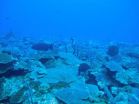(Press-News.org) Native Americans living in the Amazon bear an unexpected genetic connection to indigenous people in Australasia, suggesting a previously unknown wave of migration to the Americas thousands of years ago, a new study has found.
"It's incredibly surprising," said David Reich, Harvard Medical School professor of genetics and senior author of the study. "There's a strong working model in archaeology and genetics, of which I have been a proponent, that most Native Americans today extend from a single pulse of expansion south of the ice sheets--and that's wrong. We missed something very important in the original data."
Previous research had shown that Native Americans from the Arctic to the southern tip of South America can trace their ancestry to a single "founding population" called the First Americans, who came across the Bering land bridge about 15,000 years ago. In 2012, Reich and colleagues enriched this history by showing that certain indigenous groups in northern Canada inherited DNA from at least two subsequent waves of migration.
The new study, published July 21 in Nature, indicates that there's more to the story.
Pontus Skoglund, first author of the paper and a postdoctoral researcher in the Reich lab, was studying genetic data gathered as part of the 2012 study when he noticed a strange similarity between one or two Native American groups in Brazil and indigenous groups in Australia, New Guinea and the Andaman Islands.
"That was an unexpected and somewhat confusing result," said Reich, who is also an associate member of the Broad Institute of Harvard and MIT and a Howard Hughes Medical Investigator. "We spent a really long time trying to make this result go away and it just got stronger."
Skoglund and colleagues from HMS, the Broad and several universities in Brazil analyzed publicly available genetic information from 21 Native American populations from Central and South America. They also collected and analyzed DNA from nine additional populations in Brazil to make sure the link they saw hadn't been an artifact of how the first set of genomes had been collected. The team then compared those genomes to the genomes of people from about 200 non-American populations.
The link persisted. The Tupí-speaking Suruí and Karitiana and the Ge-speaking Xavante of the Amazon had a genetic ancestor more closely related to indigenous Australasians than to any other present-day population. This ancestor doesn't appear to have left measurable traces in other Native American groups in South, Central or North America.
The genetic markers from this ancestor don't match any population known to have contributed ancestry to Native Americans, and the geographic pattern can't be explained by post-Columbian European, African or Polynesian mixture with Native Americans, the authors said. They believe the ancestry is much older--perhaps as old as the First Americans.
In the ensuing millennia, the ancestral group has disappeared.
"We've done a lot of sampling in East Asia and nobody looks like this," said Skoglund. "It's an unknown group that doesn't exist anymore."
The team named the mysterious ancestor Population Y, after the Tupí word for ancestor, "Ypykuéra."
Reich, Skoglund and colleagues propose that Population Y and First Americans came down from the ice sheets to become the two founding populations of the Americas.
"We don't know the order, the time separation or the geographical patterns," said Skoglund.
Researchers do know that the DNA of First Americans looked similar to that of Native Americans today. Population Y is more of a mystery.
"About 2 percent of the ancestry of Amazonians today comes from this Australasian lineage that's not present in the same way elsewhere in the Americas," said Reich.
However, that doesn't establish how much of their ancestry comes from Population Y. If Population Y were 100 percent Australasian, that would indeed mean they contributed 2 percent of the DNA of today's Amazonians. But if Population Y mixed with other groups such as the First Americans before they reached the Americas, the amount of DNA they contributed to today's Amazonians could be much higher--up to 85 percent.
To answer that question, researchers would need to sample DNA from the remains of a person who belonged to Population Y. Such DNA hasn't been obtained yet. One place to look might be in the skeletons of early Native Americans whose skulls some researchers say have Australasian features. The majority of these skeletons were found in Brazil.
Reich and Skoglund think that some of the most interesting open questions about Native American population history are about the relationships among groups after the initial migrations.
"We have a broad view of the deep origins of Native American ancestry, but within that diversity we know very little about the history of how those populations relate to each other," said Reich.
INFORMATION:
This work was supported by the National Science Foundation (HOMINID grant BCS-1032255), the National Institutes of Health (GM100233), the Simons Foundation (grant 280376), the Howard Hughes Medical Institute, the Conselho Nacional de Desenvolvimento Científico e Tecnológico and Coordenação de Aperfeiçoamento de Pessoal de Nível Superior (Brazil), the Wenner-Gren Foundation and the Swedish Research Council (VR grant 2014-453).
There is archaeological evidence of modern humans in the Americas by ca. 15 thousand years ago (KYA). However, there is still debate over exactly when and how many times the ancestors of present-day Native Americans entered the New World from Siberia. A large genome-scale study conducted by an international team headed by the Centre for GeoGenetics at the University of Copenhagen has now provided answers to these questions. The study reveals that the ancestors of all present-day Native Americans arrived in the Americas as part of a single migration wave, no earlier than ...
Location-based advertisements may pinpoint customers geographically, but often miss the target because customers may find the ads creepy and intrusive, according to an international team of researchers. To overcome this negativity, the researchers suggest advertisers invite their customers to help tailor ads they might receive.
While being physically close to a product or shop improved attitudes about local advertisements on their mobile devices, customers felt significantly better about both the advertisement and location-based advertising when they had a hand in selecting ...
Emergency room physicians treating patients with alcohol-related trauma can better identify those at risk of future drinking-related trauma with a 10-point questionnaire rather than the standard blood alcohol content test, according to a study in The Journal of the American Osteopathic Association (JAOA).
The questionnaire, known as the Alcohol Use Disorders Identification Test (AUDIT), was developed by the World Health Organization to address difficulties in identifying at-risk drinking behavior. It assesses alcohol consumption, drinking behaviors and alcohol-related ...
The original Americans came from Siberia in a single wave no more than 23,000 years ago, at the height of the last Ice Age, and apparently hung out in the north - perhaps for thousands of years - before spreading in two distinct populations throughout North and South America, according to a new genomic analysis.
The findings, which will be reported in the July 24 issue of Science, confirm the most popular theory of the peopling of the Americas, but throws cold water on others, including the notion of an earlier wave of people from East Asia prior to the last glacial maximum, ...
Starting antiretroviral therapy early not only prevents serious AIDS-related diseases, but also prevents the onset of cancer, cardiovascular disease, and other non-AIDS-related diseases in HIV-infected people, according to a new analysis of data from the Strategic Timing of AntiRetroviral Treatment (START) study, the first large-scale randomized clinical trial to establish that earlier antiretroviral treatment benefits all HIV-infected individuals. Rates of both serious AIDS-related events and serious non-AIDS-related events were significantly reduced with early therapy.
The ...
The Institute of Medicine has identified interprofessional education (IPE) as a key innovation for achieving the triple aim of better care, better outcomes and reduced health care costs. Yet, a shortage of qualified faculty and difficulty with aligning learners' schedules often prevent sustainable and scalable IPE.
Now, a team of New York University researchers from both the College of Nursing (CoN) and NYU School of Medicine (SoM), are addressing the barriers to wide-spread adoption of IPE.
Led by Maja Djukic, PhD, RN, assistant professor at the CoN, and Marc Triola, ...
The United States now produces about as much crude oil as Saudi Arabia does, and enough natural gas to export in large quantities. That's thanks to hydraulic fracturing, a mining practice that involves a rock-cracking pressurized mix of water, sand and chemicals.
Ongoing research by Stanford environmental scientist Rob Jackson attempts to minimize the risks of "fracking" to underground drinking water sources.
The most recent such study, published in Environmental Science & Technology, finds that at least 6,900 oil and gas wells in the U.S. were fracked less than a mile ...
MADISON, Wis. -- Cognitive scientists have come to view the brain as a prediction machine, constantly comparing what is happening around us to expectations based on experience -- and considering what should happen next.
"These predictions, most of them unconscious, include predicting what we're about to see," says Gary Lupyan, a University of Wisconsin-Madison psychology professor.
Work in Lupyan's lab has demonstrated the predictive process through manipulating the connection between language and vision in the brain. A study published recently in The Journal of Neuroscience ...
MIAMI - Researchers discovered a threatened coral species that lives in deeper waters off the U.S. Virgin Islands is more fertile than its shallow-water counterparts. The new study showed that mountainous star corals (Orbicella faveolata) located at nearly 140 feet (43 meters) deep may produce one trillion more eggs per square kilometer (247 acres) than those on shallow reefs. The findings from scientists at the University of Miami (UM) Rosenstiel School of Marine and Atmospheric Science and the University of the Virgin Islands have important implications for the future ...
ATLANTA - July 21, 2015-If Louisiana, which has some of the highest colon cancer incidence and mortality rates in the nation, had the same risk factors, screening uptake, and survival rates as New Jersey, incidence and mortality from the disease would not only drop, they would drop to levels below that of New Jersey, according to a new study. The study, appearing in Cancer, shows that removing differences in health behavior and survival would close a gap that has appeared over the past several decades.
Decades ago, colorectal cancer incidence and mortality rates were ...



